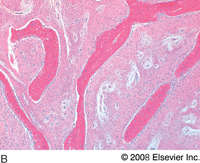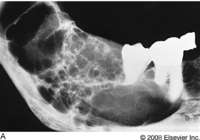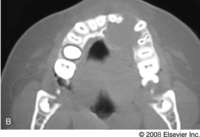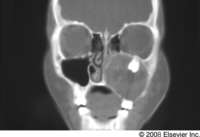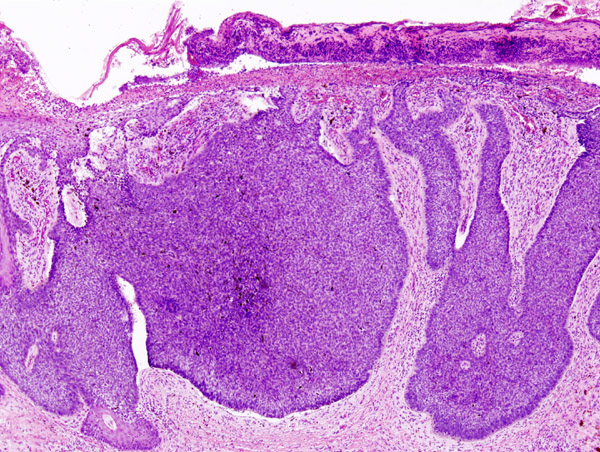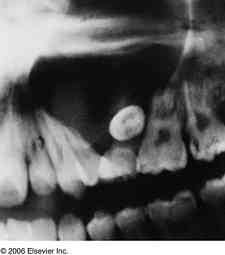Bailey's Chapter 112 - Odontogenic Cysts Tumors
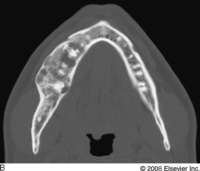
Multiple choice quiz based on Bailey's 4th ed. Otolaryngology Head and Neck Surgery Chapter 112: Odontogenic Cyts, Tumors, and Related Jaw Lesions
- 1.
A 14yo M presents with assymetrical swelling of his lower jaw. It is non-tender and has been progressively assymetric for the last year at least. On physical exam all cranial nerves are intact. His occlusion is minimally displaced. A CT Scan of a representative sample is shown below. Which of the following would be the best treatment option?
- A.
Observation with close follow up
- B.
Segmental resection of the mandible with postoperative radiation
- C.
Recontouring of the jaw surgically and orthodontics to correct malocclusion
- D.
Enucleation of the cyst with osseocurretage
Correct Answer
A. Observation with close follow upExplanation
This is an example of Fibrous Dysplasia. Fibrous dysplasia is not a true neoplasm, rather it is a tumor like condition where normal medullary bone is replaced with fibrous ocnnective tissue mixed with irregular bony trabeculae. Treatment includes recontouring of the affected jaw, and surgery is usually delayed until the affected bone has reached maturity.Rate this question:
-
- 2.
Unfortunately, the same child as above incorrectly undergoes segmental resection of the mandible one week later and we have the following histo slide to look at from the pathology. A characterisitic H&E stain of the specimen is shown below. The report indicates that the borders of the specimen are difficult to interpret due to surigical distortion (cutting) at the edges. Which of the following statements regarding this disease is FALSE?
- A.
The specimen exibits curvilinear portions of woven bone, sithout appositional osteoblasts, in a background of connective tissue stroma.
- B.
The patient is at an increased risk for sarcomatous transformation of the disease
- C.
The patient is likely to have other similar lesions in his longbones over the course of his life
- D.
Appropriate treatment would have been delayed contouring of the jaw after final growth has occurred.
- E.
This disease is a sporadic mutation in the alpha-subunit of a signal transducing G-protein
Correct Answer
C. The patient is likely to have other similar lesions in his longbones over the course of his lifeExplanation
Fibrous displasia is mostcommonly the monostotic type *occuring in one bone. rarely is it polyostotic, unless it is a component of McCune-Albright syndrome which includes cafe-au-lait skin macules and multiple endocrinopathies, including hyperthyroidism or precocious puberty.
BTW, the pt is at an increased risk for sarcomatous transformation because the pt was operated on during an active growth phaseRate this question:
-
- 3.
A middle aged male is seen for a slowly growing mass. It is located in the posterior portion of the mandible. It is asymptomatic and does not alter the sensory nerve function of the patient. Radiographically, the lesion is multilocular, with ill-defined borders. Histologically the specimen is seen below. What is the correct diagnosis?
- A.
Odontogenic Myxoma
- B.
Adenocarcinoma
- C.
Ameloblastoma
- D.
Odontogenic Keratocyst
- E.
Adenomatoid Odontogenic Cyst
Correct Answer
C. AmeloblastomaExplanation
The correct diagnosis is Ambelblastoma. The histology demonstrates a follicular pattern, with islands of odontogenic epithelium characterized by peripheral columnar cells exhibiting reverse polarity away from the basement membrane. The recurrence rate is as high as 90% if inadequately treated. However, when hard and soft tissue margins are negative, a cure rate of nearly 98% is achieved.Rate this question:
-
- 4.
An 18yo F presents with the following: . She undergoes enucleation and curretage. Pathology demonstrates:What is the correct diagnosis?
- A.
Odontogenic Myxoma
- B.
Adenocarcinoma
- C.
Ameloblastoma
- D.
Odontogenic Keratocyst
- E.
Adenomatoid Odontogenic Cyst
Correct Answer
E. Adenomatoid Odontogenic CystExplanation
AOC's are the "two thirds tumor." 2/3 are in femails in their adolescent and teenage years. 2/3 are assoicated with an unerupted tooth, of which two-thirds are associated with a canine. two-thirds arrise in the maxilla. Radiographically the AOC usually is a well0circumscribed, unilocular radiolucency assoicated withan impacted tooth. Histologically, it is highly cellular with spindoehaped cells in whorls or rosettes. Recurrence is not seen in this benign encapsulated lesion, so curettage alone is curateive.Rate this question:
-
- 5.
Unlike fibrous dysplasia, ossifying fibromas are true tumors of mesenchymal origin that have strong predilection for the tooth-bearing portion of the jaws. Which of the following statements ARE TRUE regarding these tumors (select 2)?
- A.
Their radiologic appearance is similar throughout the life of the disease process
- B.
In the mandible, they typically appear as a midbody growth at the medial border.
- C.
The juvenile form is more common and is benign
- D.
The juvenile form has a predilection for the maxilla
- E.
It is usually well demarcated
Correct Answer(s)
D. The juvenile form has a predilection for the maxilla
E. It is usually well demarcatedExplanation
Ossifying fibromas are usually well demarcated, benign lesions that present in middle aged women. An immature lesion initally presents as a radiolucency (hence the fibroma in the name) and then becomes more mixed, and eventually can become completely radiopaque ("ossifying") as it ages. The usual location is at the inferior border of the mandible, thus giving it the "hanging off the lower lateral border" appearance. The juvenile form is rare and has a more aggressive course. It does have a predilection for the maxilla.Rate this question:
-
- 6.
Which of the following is the most common inflammatory cyst?
- A.
Dentigerous Cyst
- B.
Odontogenic Keratocyst
- C.
Radicular Cyst
- D.
Nasopalatine Duct Cyst
- E.
Stafne Bone Cyst
Correct Answer
C. Radicular CystExplanation
The rest are actually developmental cysts.Rate this question:
-
- 7.
A 45yo F presents with swelling of the upper lip, pain on the maxilla, as well as sensitivity to cold. A CT scan is obtained. What is the correct diagnosis?
- A.
Periapical cyst
- B.
Dentigerous Cyst
- C.
Odontogenic Keratocyst
- D.
Nasopalatine Duct Cyst
- E.
Stafne Bone Cyst
Correct Answer
A. Periapical cystExplanation
With this history of pain and swelling, an infection is likely, and this would be consistent with a radicular cyst (otherwise known as a periapical cyst).Rate this question:
-
- 8.
A 24yo M comes to clinic for chronic postnasal drip. He has a frequent cough because of this. He has attempted many over the counter antihistamines with limited success. A referral to an allergist was made and after a negative skin test the following CT scan was obtained. He is referred to you for treatment of his sinusitis. What is the likely diagnosis?
- A.
Dentigerous Cyst
- B.
Nasopalatine Duct Cyst
- C.
Stafne bone Cyst
- D.
Fibroosseous Dysplasia
- E.
Radicular cyst
Correct Answer
A. Dentigerous CystExplanation
Although the CT scan might confuse you to think this is a nasopalatine Duct cyst, it is not in the midline. The incisince foramen is in the midline. The answer is not Radicular cyst because this is not inflamatory/acute in nature. The answer is dentigerous cyst. This would be quite difficult to answer if one of the answer choices was an Odontogenic Keratocyst due to the common similarities between the two.Rate this question:
-
- 9.
Which of the following helps to separate a dentigerous cyst from an odontogenic keratocyst?
- A.
Amyloid deposition
- B.
Rushton bodies
- C.
Unerupted teeth
- D.
Ghost cells
- E.
Cortical expansion
Correct Answer
C. Unerupted teethExplanation
A dentigerous cyst is the second most common odontoenic cyst. A Dentingerous cyst must be associated with the crown of an unerupted tooth, whereas an OKC can develop from the remnants of the dental lamina, and can occur in any jaw location. Addiontal differentiation of the OKC and dentigerous cysts are the OKC's aggressive growth, causing bony expansion and destruction and high recurrence rate.Rate this question:
-
- 10.
A 30yo M presents for a slowly growing lesion on the side of his temple. It is pearly colored and smooth. It is non ulcerative and non-tender, but has been changing in shape and he is concerned because his father and aunt both have a history of recurrent skin cancer. PSHx is significant for three oral surgeries for "cysts in his jaw", with no reactions to anesthesia. Excisional biopsy is performed resulting in the following:What other findings/problems is this patient at increased risk for having (select 3)?
- A.
Early onset chronic obstructive pulmonary disease
- B.
Cataract formation
- C.
Calcification of the falx cerebri
- D.
Palmar and plantar pitting
- E.
Meduloblastoma
Correct Answer(s)
C. Calcification of the falx cerebri
D. Palmar and plantar pitting
E. MeduloblastomaExplanation
Although not discussed in this text, meduloblastoma is seen in 5% of patients with Nevoid Basal Cell Carcinoma Syndrom (Gorlin Syndrome). Nevoid Basal Cell Carcinoma Syndrome is an autosomal dominant inherited condition that exhipts high penetrance with variable expressivity. It is a result of a mutation of the PTCH tumor suppresor gene. Interestingly, once adulthood is reached, the formation of new OKC is less problemeatic and the risk of BCC rises. Treatment of the basal cell carcinomas and the OKC's does not differ from those individuals without this disease.Rate this question:
-
- 11.
A 15yo F presents with Right Maxillary Swelling. The key findings associated with this disease include all of the following EXCEPT:
- A.
A wide range of recurrence from 5-60% depending on the surgical technique.
- B.
The preferred treatement is surgical enucleation and osseous curettage, removing the specimen in one piece.
- C.
Histologically distinct, this speicimen displays the characterisitc parakaeratinazation, with the flat epithelial-connective tissue interface resulting in a separation of the epithelium on processing.
- D.
When multiple lesions of this nature appear, one should consider the diagnosis of McCune-Albright Syndrome.
- E.
The lesions grow in a multilocular bosselated fashion with daughter cysts that extend into the surrounding bone. Because of this relationship, the tendency for recurrence is high, particularly if the original surgical treatment does not result in complete removal of the lesion.
Correct Answer
D. When multiple lesions of this nature appear, one should consider the diagnosis of McCune-Albright Syndrome.Explanation
This is an example of an odontogenic keratocyst. Multiple OKC's are seen in Nevoid Basal Cell Carcinoma syndrome (Gorlin Syndrome).
McCune-Albright Syndrome is associated with polyostoti fibrous dysplasia.Rate this question:
-
Quiz Review Timeline +
Our quizzes are rigorously reviewed, monitored and continuously updated by our expert board to maintain accuracy, relevance, and timeliness.
-
Current Version
-
Mar 21, 2023Quiz Edited by
ProProfs Editorial Team -
Jan 23, 2010Quiz Created by
Resident
 Back to top
Back to top



